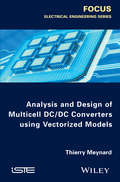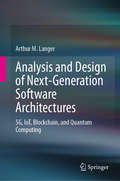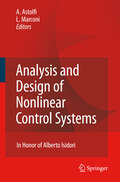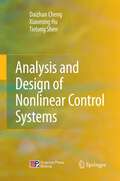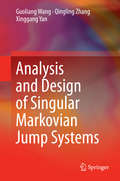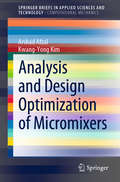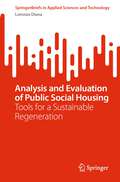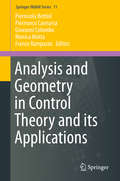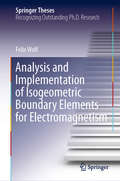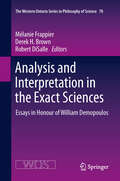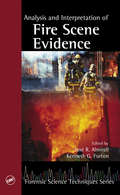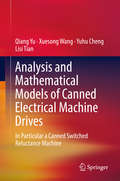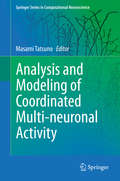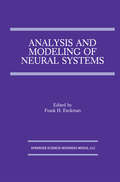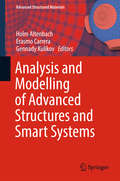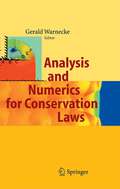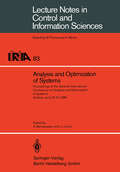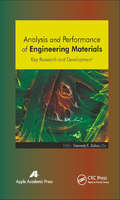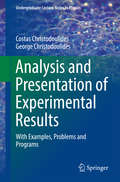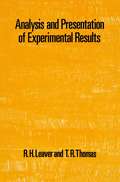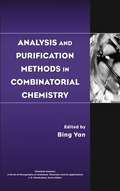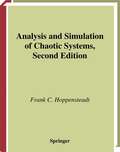- Table View
- List View
Analysis and Design of Multicell DC/DC Converters Using Vectorized Models
by Thierry MeynardShows how the concepts of vectorization and design masks can be used to help the designer in comparing different designs and making the right choices. The book addresses series and parallel multicell conversion directly, and the concepts can be generalized to describe other topologies.
Analysis and Design of Multicell DC/DC Converters Using Vectorized Models
by Thierry MeynardShows how the concepts of vectorization and design masks can be used to help the designer in comparing different designs and making the right choices. The book addresses series and parallel multicell conversion directly, and the concepts can be generalized to describe other topologies.
Analysis and Design of Next-Generation Software Architectures: 5G, IoT, Blockchain, and Quantum Computing
by Arthur M. LangerThis book provides a detailed “how-to” guide, addressing aspects ranging from analysis and design to the implementation of applications, which need to be integrated within legacy applications and databases.The analysis and design of the next generation of software architectures must address the new requirements to accommodate the Internet of things (IoT), cybersecurity, blockchain networks, cloud, and quantum computer technologies. As 5G wireless increasingly establishes itself over the next few years, moving legacy applications into these new architectures will be critical for companies to compete in a consumer-driven and social media-based economy. Few organizations, however, understand the challenges and complexities of moving from a central database legacy architecture to a ledger and networked environment.The challenge is not limited to just designing new software applications. Indeed, the next generation needs to function more independently on various devices, and on more diverse and wireless-centric networks. Furthermore, databases must be broken down into linked list-based blockchain architectures, which will involve analytic decisions regarding which portions of data and metadata will be processed within the chain, and which ones will be dependent on cloud systems. Finally, the collection of all data throughout these vast networks will need to be aggregated and used for predictive analysis across a variety of competitive business applications in a secured environment. Certainly not an easy task for any analyst/designer!Many organizations will continue to use packaged products and open-source applications. These third-party products will need to be integrated into the new architecture paradigms and have seamless data aggregation capabilities, while maintaining the necessary cyber compliances. The book also clearly defines the roles and responsibilities of the stakeholders involved, including the IT departments, users, executive sponsors, and third-party vendors. The book’s structure also provides a step-by-step method to help ensure a higher rate of success in the context of re-engineering existing applications and databases, as well as selecting third-party products, conversion methods and cybercontrols. It was written for use by a broad audience, including IT developers, software engineers, application vendors, business line managers, and executives.
Analysis and Design of Nonlinear Control Systems: In Honor of Alberto Isidori
by Alessandro Astolfi Lorenzo MarconiThis book is a tribute to Prof. Alberto Isidori on the occasion of his 65th birthday. Prof. Isidori’s proli?c, pioneering and high-impact research activity has spanned over 35 years. Throughout his career, Prof. Isidori has developed ground-breaking results, has initiated researchdirections and has contributed towardsthe foundationofnonlinear controltheory.In addition,his dedication to explain intricate issues and di?cult concepts in a simple and rigorous way and to motivate young researchers has been instrumental to the intellectual growth of the nonlinear control community worldwide. The volume collects 27 contributions written by a total of 52 researchers. The principal author of each contribution has been selected among the - searchers who have worked with Prof. Isidori, have in?uenced his research activity, or have had the privilege and honour of being his PhD students. The contributions address a signi?cant number of control topics, including th- retical issues, advanced applications, emerging control directions and tutorial works. The diversity of the areas covered, the number of contributors and their international standing provide evidence of the impact of Prof. Isidori in the control and systems theory communities. The book has been divided into six parts: System Analysis, Optimization Methods, Feedback Design, Regulation, Geometric Methods and Asymptotic Analysis, re?ecting important control areas which have been strongly in- enced and, in some cases, pioneered by Prof. Isidori.
Analysis and Design of Nonlinear Control Systems
by Daizhan Cheng Xiaoming Hu Tielong Shen"Analysis and Design of Nonlinear Control Systems" provides a comprehensive and up to date introduction to nonlinear control systems, including system analysis and major control design techniques. The book is self-contained, providing sufficient mathematical foundations for understanding the contents of each chapter. Scientists and engineers engaged in the field of Nonlinear Control Systems will find it an extremely useful handy reference book. Dr. Daizhan Cheng, a professor at Institute of Systems Science, Chinese Academy of Sciences, has been working on the control of nonlinear systems for over 30 years and is currently a Fellow of IEEE and a Fellow of IFAC, he is also the chairman of Technical Committee on Control Theory, Chinese Association of Automation.
Analysis and Design of Singular Markovian Jump Systems
by Guoliang Wang Qingling Zhang Xinggang YanThis monograph is an up-to-date presentation of the analysis and design of singular Markovian jump systems (SMJSs) in which the transition rate matrix of the underlying systems is generally uncertain, partially unknown and designed. The problems addressed include stability, stabilization, H∞ control and filtering, observer design, and adaptive control. applications of Markov process are investigated by using Lyapunov theory, linear matrix inequalities (LMIs), S-procedure and the stochastic Barbalat’s Lemma, among other techniques.Features of the book include:· study of the stability problem for SMJSs with general transition rate matrices (TRMs);· stabilization for SMJSs by TRM design, noise control, proportional-derivative and partially mode-dependent control, in terms of LMIs with and without equation constraints;· mode-dependent and mode-independent H∞ control solutions with development of a type of disordered controller;· observer-based controllers of SMJSs in which both the designed observer and controller are either mode-dependent or mode-independent;· consideration of robust H∞ filtering in terms of uncertain TRM or filter parameters leading to a method for totally mode-independent filtering· development of LMI-based conditions for a class of adaptive state feedback controllers with almost-certainly-bounded estimated error and almost-certainly-asymptotically-stable corresponding closed-loop system states· applications of Markov process on singular systems with norm bounded uncertainties and time-varying delaysAnalysis and Design of Singular Markovian Jump Systems contains valuable reference material for academic researchers wishing to explore the area. The contents are also suitable for a one-semester graduate course.
Analysis and Design Optimization of Micromixers (SpringerBriefs in Applied Sciences and Technology)
by Arshad Afzal Kwang-Yong KimThis book illustrates the computational framework based on knowledge of flow and mass transfer together with optimization techniques to solve problems relevant to micromixing technology. The authors provide a detailed analysis of the different numerical techniques applied to the design of micromixers. Flow and mixing analysis is based on both the Eulerian and Lagrangian approaches; relative advantages and disadvantages of the two methods and suitability to different types of mixing problems are analysed. The book also discusses the various facets of numerical schemes subjected to discretization errors and computational grid requirements. Since a large number of studies are based on commercial computational fluid dynamics (CFD) packages, relevant details of these packages to the mixing problem using them are presented. Numerical optimization techniques coupled with CFD analysis of flow and mixing have proved to be an important tool for micromixers design, and therefore, are an important part of the book. These techniques are presented briefly, and focus is on surrogate modeling and optimization applied to design of micromixers.
Analysis and Evaluation of Public Social Housing: Tools for a Sustainable Regeneration (SpringerBriefs in Applied Sciences and Technology)
by Lorenzo DianaThe book explores current characteristics of the urban built environment in view of possible future transformations. A cross-reading analysis of existing public social housing buildings is proposed, based on the investigation of their architectural, structural, and energetic characteristics. The study aims to provide an integrated approach that captures the link between typology, construction, and energy demands, offering a key to understanding the main critical issues and transformation readiness. It focuses on large-scale interventions composing public social housing stocks, realized during the second half of the twentieth century. More than other public interventions, such building stocks clearly lack in meeting current housing needs such as modern apartment architectural layout, energy and structural regulations, and social mix. However, due to their numerical presence, strategical and widespread distribution across urban areas, and transformability, these buildings can be the target for future strategic regeneration projects. In particular, the book thoroughly investigates the social housing estate constructed in Rome (Italy) after the approval in 1964 of the first urban economic and social housing plan.
Analysis and Geometry in Control Theory and its Applications (Springer INdAM Series #11)
by Piernicola Bettiol Piermarco Cannarsa Giovanni Colombo Monica Motta Franco RampazzoSince the 1950s control theory has established itself as a major mathematical discipline, particularly suitable for application in a number of research fields, including advanced engineering design, economics and the medical sciences. However, since its emergence, there has been a need to rethink and extend fields such as calculus of variations, differential geometry and nonsmooth analysis, which are closely tied to research on applications. Today control theory is a rich source of basic abstract problems arising from applications, and provides an important frame of reference for investigating purely mathematical issues. In many fields of mathematics, the huge and growing scope of activity has been accompanied by fragmentation into a multitude of narrow specialties. However, outstanding advances are often the result of the quest for unifying themes and a synthesis of different approaches. Control theory and its applications are no exception. Here, the interaction between analysis and geometry has played a crucial role in the evolution of the field. This book collects some recent results, highlighting geometrical and analytical aspects and the possible connections between them. Applications provide the background, in the classical spirit of mutual interplay between abstract theory and problem-solving practice.
Analysis and Implementation of Isogeometric Boundary Elements for Electromagnetism (Springer Theses)
by Felix WolfThis book presents a comprehensive mathematical and computational approach for solving electromagnetic problems of practical relevance, such as electromagnetic scattering and the cavity problems. After an in-depth introduction to the mathematical foundations of isogeometric analysis, which discusses how to conduct higher-order simulations efficiently and without the introduction of geometrical errors, the book proves quasi-optimal approximation properties for all trace spaces of the de Rham sequence, and demonstrates inf-sup stability of the isogeometric discretisation of the electric field integral equation (EFIE). Theoretical properties and algorithms are described in detail. The algorithmic approach is, in turn, validated through a series of numerical experiments aimed at solving a set of electromagnetic scattering problems. In the last part of the book, the boundary element method is combined with a novel eigenvalue solver, a so-called contour integral method. An algorithm is presented, together with a set of successful numerical experiments, showing that the eigenvalue solver benefits from the high orders of convergence offered by the boundary element approach. Last, the resulting software, called BEMBEL (Boundary Element Method Based Engineering Library), is reviewed: the user interface is presented, while the underlying design considerations are explained in detail. Given its scope, this book bridges an important gap between numerical analysis and engineering design of electromagnetic devices.
Analysis and Interpretation in the Exact Sciences: Essays in Honour of William Demopoulos (The Western Ontario Series in Philosophy of Science #78)
by Melanie Frappier, Derek Brown and Robert DiSalleThe essays in this volume concern the points of intersection between analytic philosophy and the philosophy of the exact sciences. More precisely, it concern connections between knowledge in mathematics and the exact sciences, on the one hand, and the conceptual foundations of knowledge in general. Its guiding idea is that, in contemporary philosophy of science, there are profound problems of theoretical interpretation-- problems that transcend both the methodological concerns of general philosophy of science, and the technical concerns of philosophers of particular sciences. A fruitful approach to these problems combines the study of scientific detail with the kind of conceptual analysis that is characteristic of the modern analytic tradition. Such an approach is shared by these contributors: some primarily known as analytic philosophers, some as philosophers of science, but all deeply aware that the problems of analysis and interpretation link these fields together.
Analysis and Interpretation of Fire Scene Evidence
by Kenneth G. Furton Jose R. AlmirallOngoing advances in arson detection tools and techniques increase the importance of scientific evidence in related court proceedings. In order to assemble an airtight case, investigators and forensic scientists need a resource that assists them in properly conducting the chemical analysis and interpretation of physical evidence found at scenes of s
Analysis and Interpretation of Fire Scene Evidence
by José R. Almirall Kenneth G. FurtonOngoing advances in arson detection tools and techniques increase the importance of scientific evidence in related court proceedings. In order to assemble an airtight case, investigators and forensic scientists need a resource that assists them in properly conducting the chemical analysis and interpretation of physical evidence found at scenes of s
Analysis and Mathematical Models of Canned Electrical Machine Drives
by Qiang Yu Xuesong Wang Yuhu Cheng Lisi TianThis book focuses on the electromagnetic and thermal modeling and analysis of electrical machines, especially canned electrical machines for hydraulic pump applications. It addresses both the principles and engineering practice, with more weight placed on mathematical modeling and theoretical analysis. This is achieved by providing in-depth studies on a number of major topics such as: can shield effect analysis, machine geometry optimization, control analysis, thermal and electromagnetic network models, magneto motive force modeling, and spatial magnetic field modeling. For the can shield effect analysis, several cases are studied in detail, including classical canned induction machines, as well as state-of-the-art canned permanent magnet machines and switched reluctance machines. The comprehensive and systematic treatment of the can effect for canned electrical machines is one of the major features of this book, which is particularly suited for readers who are interested in learning about electrical machines, especially for hydraulic pumping, deep-sea exploration, mining and the nuclear power industry. The book offers a valuable resource for researchers, engineers, and graduate students in the fields of electrical machines, magnetic and thermal engineering, etc.
Analysis and Modeling of Coordinated Multi-neuronal Activity (Springer Series in Computational Neuroscience #12)
by Masami TatsunoSince information in the brain is processed by the exchange of spikes among neurons, a study of such group dynamics is extremely important in understanding hippocampus dependent memory. These spike patterns and local field potentials (LFPs) have been analyzed by various statistical methods. These studies have led to important findings of memory information processing. For example, memory-trace replay, a reactivation of behaviorally induced neural patterns during subsequent sleep, has been suggested to play an important role in memory consolidation. It has also been suggested that a ripple/sharp wave event (one of the characteristics of LFPs in the hippocampus) and spiking activity in the cortex have a specific relationship that may facilitate the consolidation of hippocampal dependent memory from the hippocampus to the cortex. The book will provide a state-of-the-art finding of memory information processing through the analysis of multi-neuronal data. The first half of the book is devoted to this analysis aspect. Understanding memory information representation and its consolidation, however, cannot be achieved only by analyzing the data. It is extremely important to construct a computational model to seek an underlying mathematical principle. In other words, an entire picture of hippocampus dependent memory system would be elucidated through close collaboration among experiments, data analysis, and computational modeling. Not only does computational modeling benefit the data analysis of multi-electrode recordings, but it also provides useful insight for future experiments and analyses. The second half of the book will be devoted to the computational modeling of hippocampus-dependent memory.
Analysis and Modelling of Advanced Structures and Smart Systems (Advanced Structured Materials #81)
by Holm Altenbach Erasmo Carrera Gennady KulikovThis book presents selected papers presented at the 8th International Conference "Design, Modeling and Experiments of Advanced Structures and Systems" (DeMEASS VIII, held in Moscow, Russia in May 2017) and reflects the modern state of sciences in this field. The contributions contain topics like Piezoelectric, Ferroelectric, Ferroelastic and Magnetostrictive Materials, Shape Memory Alloys and Active Polymers, Functionally Graded Materials, Multi-Functional Smart Materials and Structures, Coupled Multi-Field Problems, Design and Modeling of Sensors and Actuators, Adaptive Structures.
Analysis and Numerics for Conservation Laws
by Gerald WarneckeWhatdoasupernovaexplosioninouterspace,?owaroundanairfoil and knocking in combustion engines have in common? The physical and chemical mechanisms as well as the sizes of these processes are quite di?erent. So are the motivations for studying them scienti?cally. The super- 8 nova is a thermo-nuclear explosion on a scale of 10 cm. Astrophysicists try to understand them in order to get insight into fundamental properties of the universe. In ?ows around airfoils of commercial airliners at the scale of 3 10 cm shock waves occur that in?uence the stability of the wings as well as fuel consumption in ?ight. This requires appropriate design of the shape and structure of airfoils by engineers. Knocking occurs in combustion, a chemical 1 process, and must be avoided since it damages motors. The scale is 10 cm and these processes must be optimized for e?ciency and environmental conside- tions. The common thread is that the underlying ?uid ?ows may at a certain scale of observation be described by basically the same type of hyperbolic s- tems of partial di?erential equations in divergence form, called conservation laws. Astrophysicists, engineers and mathematicians share a common interest in scienti?c progress on theory for these equations and the development of computational methods for solutions of the equations. Due to their wide applicability in modeling of continua, partial di?erential equationsareamajor?eldofresearchinmathematics. Asubstantialportionof mathematical research is related to the analysis and numerical approximation of solutions to such equations. Hyperbolic conservation laws in two or more spacedimensionsstillposeoneofthemainchallengestomodernmathematics.
Analysis and Optimization of Systems: Proceedings of the Seventh International Conference on Ana- lysis and Optimization of Systems. Antibes, June 25-27, 1986 (Lecture Notes in Control and Information Sciences #83)
by A. Bensoussan J. L. LionsINRIA, Institut National de Recherche en Informatique et en Automatique
Analysis and Performance of Engineering Materials: Key Research and Development
by Gennady E. ZaikovThis new book facilitates the study of problematic chemicals in such applications as chemical fate modeling, chemical process design, and experimental design. It provides a valuable overview of current chemical processes, products, and practices and analyzes theories to formulate and prove physicochemical principles. It addresses the production and
Analysis and Presentation of Experimental Results: With Examples, Problems and Programs (Undergraduate Lecture Notes in Physics)
by Costas Christodoulides George ChristodoulidesThis book is intended as a guide to the analysis and presentation of experimental results. It develops various techniques for the numerical processing of experimental data, using basic statistical methods and the theory of errors. After presenting basic theoretical concepts, the book describes the methods by which the results can be presented, both numerically and graphically. The book is divided into three parts, of roughly equal length, addressing the theory, the analysis of data, and the presentation of results. Examples are given and problems are solved using the Excel, Origin, Python and R software packages. In addition, programs in all four languages are made available to readers, allowing them to use them in analyzing and presenting the results of their own experiments. Subjects are treated at a level appropriate for undergraduate students in the natural sciences, but this book should also appeal to anyone whose work involves dealing with experimental results.
Analysis and Purification Methods in Combinatorial Chemistry (Chemical Analysis: A Series of Monographs on Analytical Chemistry and Its Applications #242)
by Bing YanQuality measurement, control, and improvement in combinatorial chemistry Combinatorial chemistry has developed rapidly in the past decade, with great advances made by scientists working on analysis and purification of a large number of compounds and the analysis of polymer-bound compounds. However, formidable challenges lie ahead of today's researcher. For example, high-throughput analysis and purification technologies must be further developed to ensure combinatorial libraries are "purifiable," and "drugable." To this end, Analysis and Purification Methods in Combinatorial Chemistry describes various analytical techniques and systems for the development, validation, quality control, purification, and physicochemical testing of combinatorial libraries. A new volume in Wiley's Chemical Analysis series, this text has four parts covering: * Various approaches to monitoring reactions on solid support and optimizing reactions for library synthesis * High-throughput analytical methods used to analyze the quality of libraries * High-throughput purification techniques * Analytical methods applied in post-synthesis and post-purification stages Drawing from the contributions of respected experts in combinatorial chemistry, this comprehensive book provides coverage of applications of Nuclear Magnetic Resonance (NMR), liquid chromatography/mass spectrometry (LC/MS), Fourier Transform Infrared (FTIR), micellar electrokinetic chromatography (MEKC) technologies, as well as other analytical techniques. This eminently useful volume is an essential addition to the library of students and researchers studying or working in analytical chemistry, combinatorial chemistry, medicinal chemistry, organic chemistry, biotechnology, biochemistry, or biophysics.
Analysis and Simulation of Chaotic Systems (Applied Mathematical Sciences #94)
by Frank C. HoppensteadtBeginning with realistic mathematical or verbal models of physical or biological phenomena, the author derives tractable models for further mathematical analysis or computer simulations. For the most part, derivations are based on perturbation methods, and the majority of the text is devoted to careful derivations of implicit function theorems, the method of averaging, and quasi-static state approximation methods. The duality between stability and perturbation is developed and used, relying heavily on the concept of stability under persistent disturbances. Relevant topics about linear systems, nonlinear oscillations, and stability methods for difference, differential-delay, integro-differential and ordinary and partial differential equations are developed throughout the book. For the second edition, the author has restructured the chapters, placing special emphasis on introductory materials in Chapters 1 and 2 as distinct from presentation materials in Chapters 3 through 8. In addition, more material on bifurcations from the point of view of canonical models, sections on randomly perturbed systems, and several new computer simulations have been added.
Analysis and Simulation of Contact Problems (Lecture Notes in Applied and Computational Mechanics #27)
by Peter Wriggers Udo NackenhorstThis carefully edited book offers a state-of-the-art overview on formulation, mathematical analysis and numerical solution procedures of contact problems. The contributions collected in this volume summarize the lectures presented by leading scientists in the area of contact mechanics, during the 4th Contact Mechanics International Symposium (CMIS) held in Hannover, Germany, 2005.
